 Last additions - Japan-America Relations Postcards Last additions - Japan-America Relations Postcards |
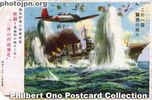
Wartime Mitsui Life Insurance ad card. Dated Feb. 1942, this advertising postcard shows a Japanese torpedo bomber dropping a torpedo aimed at a US battleship under heavy attack. An American flag (faint) can be seen on the ship's mast.Dated Feb. 1942, this advertising postcard shows a Japanese torpedo bomber dropping a torpedo aimed at a US battleship under heavy attack. An American flag (faint) can be seen on the ship's mast. The advertising copy reads, "This one shot is a phenomenal force." On the left, the text reads, "A new weapon for national savings." "Very low insurance premiums." "Mitsui's provision for old age" "It has no enemies!" For some reason, the left corners of the card were cut with scissors, perhaps to remove it from an album.
Needless to say, the lowest point in US-Japan relations was World War II. The Pearl Harbor attack, the internment of Japanese-Americans, battles at Midway and other Pacific islands, Tokyo fire bombing raids, land battle on Okinawa, and the nuclear bombing of Hiroshima and Nagasaki still reverberate among the generations today. Every year in August in Japan, ceremonies are held to mark and memorialize the Hiroshima and Nagasaki bombings and the war's end. All the while, Dec. 8 (7 in Hawaii) is just another day in Japan with no particular significance.
Of course in Hawaii, Dec. 7 is a day of national mourning as much as Hiroshima/Nagasaki Day in Japan. Each country mourns its own and neither seems to care about the other's war dead. I await the day when both countries mourn for each other as well as for themselves. After all, we all belong to the same family, the Family of Man.Sep 19, 2008
|
|
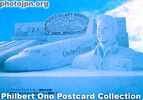
1993 Sapporo Snow Festival. In Sept. 1992, US-Japan relations literally reached new heights with Mamoru Mohri becoming the first Japanese to fly on a US Space Shuttle.On board the Endeavor, Mohri worked on numerous Skylab experiments as a payload specialist during the eight-day mission. He even conducted a "space classroom" with kids in Japan via a live TV broadcast.
This postcard shows the snow sculptures of the Space Shuttle Endeavor, the mission's patch, and a bust of Mohri built for the 44th Sapporo Snow Festival held in Feb. 1993 in Sapporo, Hokkaido. On the left side of the sculpture, you can see ice slides for children.Sep 19, 2008
|
|

Cherry Blossoms, Potomac Park, Washington, DC. In this postcard, the Bureau of Engraving and Printing and the U.S. Capitol Dome are in the background. This card was made in the USA in the late 1930s or early 1940s.The cherry trees must be the prettiest and most appreciated gift Japan has ever presented to the United States. The trees are truly a national treasure, for both countries. Today, there are over 3,700 cherry trees accenting Potomac Park and the Washington Monument. They are carefully maintained by arbor specialists.Sep 19, 2008
|
|

Rickshaw ride in Yokohama. The caption reads "Navy Musicians enjoying a Rickasha Ride in Yokohama, Japan." Since the card was printed by an American publisher, I'm assuming that they are Americans.Sep 19, 2008
|
|
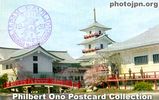
Japan Pavilion at Golden Gate International Expo, 1939. In 1939, the Golden Gate International Exposition was held in San Francisco, California's Treasure Island from February 19, 1939 to October 29, 1939. The expo theme was "Pageant of the PacifPacific Rim countries participated with pavilions having distinctive architecture, landscape, and art. The Japan Pavilion looked quite elaborate with a pagoda, Japanese-style bridge, and two large temple-like buildings.
It was a peaceful gathering of nations and it's sad that only two years later, Japan and America were at war with each other.Sep 19, 2008
|
|

Cherry Blossoms, Potomac Park, Washington, DC。. Postcard made in the USA in the late 1930s or early 1940s. It was in 1912 (the year the Titanic sank) when Viscountess Chinda, the wife of Japan's Ambassador to the U.S., gave 2,000 small cherry trees.It was in 1912 (the year the Titanic sank) when Viscountess Chinda, the wife of Japan's Ambassador to the U.S., gave 2,000 small cherry trees to Mrs. Helen Taft, the wife of President Willian Taft. In a quiet ceremony, Mrs. Taft and Viscountess Chinda planted the first two cherry trees along the Tidal Basin in Potomac Park in Washington, DC. These two trees still exist today, marked by a special plaque. .
To read more about the interesting history of these cherry trees, see the National Park Service's Web site on the Washington Cherry Trees. You can read about how the original shipment of 2,000 cherry trees from Tokyo in 1910 had to be destroyed upon arrival in the US due to the infestation of harmful insects and diseases.Sep 19, 2008
|
|
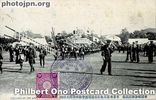
Welcome Parade for the American Fleet (Hibiya Park)Sep 19, 2008
|
|
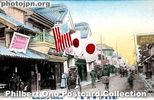
Benten-dori street in Yokohama.Sep 19, 2008
|
|
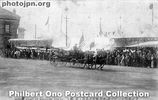
Welcome Parade for the American Fleet. The fleet's crew enjoyed a few days in Japan and was given the red-carpet treatment. A welcoming parade was given in downtown Tokyo around Shimbashi (pictured above) and Hibiya Park.A large turnout is apparent in this photo showing a horse-drawn carriage carrying the US and Japanese flags.
American crewmen held Japanese paper umbrellas with a star design, while the Japanese and American flags were everywhere. Japan was highly in favor of peaceful relations with the U.S. The American sailors were surprised and delighted by the friendliness and hospitality of the Japanese.Sep 19, 2008
|
|

Welcome Parade for the American Fleet (back). The back of the postcard (see preceding postcard) had a note talking about the American Fleet's visit to Tokyo. Postmarked Oct. 21, 1908.Notice that the dividing line is not at the center of the card. Two-thirds of the card was for the recipient's address and only one-third was for the message. Cards like this with off-center dividers were published between March 28, 1907 and March 1, 1918 when the divider was moved to the center of the card. Before March 28, 1907, there was no divider on the back and only the recipient's address could be written. The message had to be written on the picture side which usually had a large white space for writing. Looking at the back of the postcard for the divider is another way to find out the approximate date of the card.Sep 19, 2008
|
|
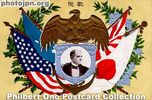
"Great White Fleet" Visiting Japan in Oct. 1908. On Dec. 16, 1907, sixteen U.S. battleships departed Hampton Roads, Virginia for a historic tour around the world. President Theodore Roosevelt was on hand to see the fleet off."Great White Fleet" Visiting Japan in Oct. 1908. On Dec. 16, 1907, sixteen U.S. battleships departed Hampton Roads, Virginia for a historic tour around the world. President Theodore Roosevelt was on hand to see the fleet off. Dubbed the "Great White Fleet" because of the white-painted hulls of the ships, the powerful flotilla's mission was to promote goodwill and to show any potential enemy (especially Japan) the U.S. Navy's vast naval power.
The fleet was first commanded by Rear Admiral Robley "Fighting Bob" Evans. He later fell ill and was replaced by Rear Admiral Charles Sperry. The person pictured in the postcard is Sperry. A series of postcards were issued by Japan's Department of Communications in commemoration of the fleet's visit to Japan (Yokohama). The card above and below are from this series. The kanji characters above the eagle's head reads "Kangei" which means welcome.Sep 19, 2008
|
|

Pictured here is one of the U.S. battleships in the fleet. The words "American Fleet" are also spelled out by the anchor rope along the bottom of the photo. The Amphitrite, Puritan, and Montgomery were among the ships making the tour.Welcome American Fleet, Oct. 1908
After leaving the U.S., the fleet cruised around South America's Cape Horn, up the U.S. West Coast to San Francisco, across the Pacific Ocean to Hawaii, visited Australia and New Zealand, then stopped in Yokohama, Japan on Oct. 18-24, 1908. Then the fleet sailed across the Indian Ocean, the Suez Canal, the Mediterranean, and the North Atlantic ocean before returning triumphantly to Hampton Roads, Virginia on Feb. 22, 1909. President Roosevelt was there to greet the return of his proud Great White Fleet. It was a 46,000-mile cruise.
It's interesting to note that as a means of long-distance transportation, ships were much more advanced than anything else. Ford's Model T was built in 1908, and the Wright Brothers sold their first flyer (a one-seater) to the U.S. Army in 1909 after a dazzling and record-breaking flight time of 1 hour and 20 min. (altitude: 300 feet).Sep 19, 2008
|
|
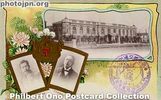
Japan-America Cable by Communications Department. Another postcard marking the cable's opening. This card was issued by Japan's Communications Department (building pictured) that was in charge of the postal system. On the right is the Comm. MinistThe commemorative rubber stamp says "Congratulation for the Opening of the Japan-America Cable" and shows a map of the cable route and the US and Japanese flags.Sep 19, 2008
|
|
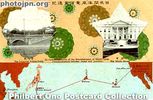
Japan-America Cable Route. With a crudely drawn map, this card shows the route of the undersea cable between Japan and America.The cable extended across the Pacific Ocean via the Bonin Islands (Ogasawara Islands), Guam, Midway, and Hawaii. The cable also connected Japan with the Philippines and Shanghai, China.
On the upper half the card, you see the Imperial Palace on the left and the White House on the right. The caption at the center of the card reads, "In Commemoration of the Establishment of Direct Cable Communication between Japan and America." It's sad to think that these two friendly nations went to war with each other a few decades later.Sep 19, 2008
|
|
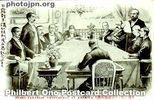
Russo-Japan Peace Conference at Portsmouth. The Japanese delegation headed by Jutaro Komura is on the left and Count Sergei Witte leads the Russian delegation on the right side of the table. The room apparently had a nice view of the ocean.Although President Roosevelt did not attend the peace conference at Portsmouth, he supervised every detail from Washington and his home on Long Island. Komura was instructed by Tokyo to make sure to obtain a free hand in Korea and control of Southern Manchuria and the railway. Also, for the frosting on the cake, to obtain an indemnity and all of Sakhalin. Japan was in dire financial straits and needed the indemnity to pay for the war and have enough capital for projects in Korea and Manchuria.
Komura got his demands for controlling Korea and Manchuria, but Count Witte rejected demands for an indemnity and Sakhalin. Komura then threatened to walk out of the conference. However, Tokyo told him to compromise. Komura offered to give up on the indemnity if Russia left Sakhalin. Witte accepted and Japan got the southern half of Sakhalin. The Treaty of Postsmouth was signed in Sept. 1905. However, when the Japanese people back home found out that there would be no indemnity, anti-peace rioting occurred. Mobs surrounded the US legation in Tokyo. Komura feared for his life when he returned to Japan.Sep 19, 2008
|
|
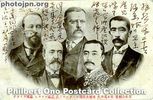
Russo-Japan Peace Conference representatives. Left to right: Russian Finance Minister Count Sergei Witte, Baron Rosen, US President Theodore Roosevelt, Japanese Ambassador to the US Kogoro Takahira, and Japanese Foreign Minister Jutaro Komura.It was a time when nations jostled for territory and trade. The Russo-Japanese War of 1904-05 was waged mainly for the control of Manchuria and Korea. The US fully supported Japan and hoped that Japan would keep Korea open to all nations for commerce. The war started before it was declared with Japan launching a surprise attack to destroy part of the Russian fleet at Port Arthur in Manchuria and landing troops in Korea. The US and Great Britain cheered Japan. The US assumed that Japan would open up Asian markets. President Theodore Roosevelt believed that Japan was fighting Russia for America. But then, he also feared that if Japan won the war, there might be a struggle between the US and Japan in the future.
In the famous Battle of the Sea of Japan on May 27-28, 1905, Japan astonishingly defeated the Russian fleet which had sailed from the Baltic Sea eighteen months before. Even before this battle, Japan was financially drained and asked Roosevelt to mediate an end to the war. Although Japan was winning the war, they were outnumbered by the Russians who had the troops and resources to keep fighting. The Russian czar, however, finally relented after seeing his Baltic fleet destroyed.
A peace conference was held at Portsmouth, New Hampshire in July and Aug. 1905. The principle representatives are pictured in the postcard above. The caption on the bottom of the card identifies these men. The Japanese handwriting in-between is only correspondence and not part of the original postcard which has a postmark dated Aug. 30, 1905.
Harvard-educated Jutaro Komura was a star in Japan's Foreign Ministry and a successful diplomat in Washington DC and Peking. He was in favor of obtaining control in both Manchuria and Korea. Komura also was instrumental in having Japan form an alliance with Great Britain in 1902. This move further strengthened Japan's position vis-a-vis Russia. Anybody attacking Japan would also have to face the British who had the world's largest navy.
Count Sergei Witte created the Trans-Siberian railway and he was highly respected by the US.
For mediating peace between Japan and Russia, President Roosevelt went on to become the first American to win the Nobel Peace Prize in 1906.Sep 19, 2008
|
|

Commodore Perry Landing Monument. The Perry monument at Kurihama on the Miura Peninsula (Kanagawa Pref.) was built on July 14, 1901. It marks the spot where he first landed in Japan in 1853.Click to see what the monument looks like today. I wonder what happened to it during the World War II. Was it destroyed or left untouched? This postcard was made to commemorate the visit of the US Fleet in Oct. 1908.Sep 19, 2008
|
|
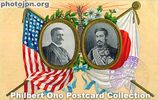
Opening of the Japan-America Cable. This postcard is one of a series of cards which commemorated the opening of the undersea communications cable between Japan and America on Aug. 1, 1906. The head of state and flags of both countries are shown.On the left is US President Theodore Roosevelt and on the right is Emperor Meiji.Sep 19, 2008
|
|

U.S.S. Mississippi. This was one of the four "black ships" in Commodore Perry 's fleet when he first visited Japan in 1853. This postcard was made to commemorate the construction (in 1901) of the monument (see next postcard) marking Perry�U.S.S. Mississippi. This was one of the four "black ships" in Commodore Perry 's fleet when he first visited Japan in 1853. This postcard was made to commemorate the construction (in 1901) of the monument (see next postcard) marking Perry's first landing in Tokyo Bay.Sep 19, 2008
|
|
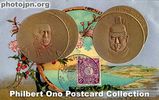
Commodore Perry and Naosuke Ii (embossed). This is another postcard issued in 1909 to commemorate the 50th anniversary of the opening of Yokohama Port. It has a commemorative postmark marking the "Jubilee of Opening of Yokohama Port."Yokohama Port was officially opened to foreign trade on July 1, 1859 in accordance with the US-Japan Treaty of Amity and Commerce.
Also see the caption for the preceding postcard.Sep 19, 2008
|
|

Naosuke Ii and Commodore Perry. Issued in 1909, this postcard commemorates the 50th anniversary of the opening of Yokohama Port. It has a commemorative postmark marking the "Jubilee of Opening of Yokohama Port."Yokohama Port was officially opened to foreign trade on July 1, 1859 in accordance with the US-Japan Treaty of Amity and Commerce.
The card honors Naosuke Ii and Commodore Matthew C. Perry. You could say that Japan-America relations started with these two men. Ii was the Tokugawa shogunate's Great Elder (Tairo) who favored and concluded commercial treaties with the Western powers and thus broke Japan's isolation from the world. Foreigners were then allowed to trade with Japan and take up residence in cities like Yokohama and Hakodate. Ii was later assassinated in 1860 by people who sought to oust the foreign "barbarians."
Commodore Perry first came to Japan in July 1853 with his four warships which the Japanese called "black ships" (kurobune). No diplomatic breakthrough was made, but Perry's knocking on Japan's door was heard loud and clear. Running low on provisions, Perry departed for China and promised to return to Japan which he did in Feb. 1854. This time he got what he wanted. The Treaty of Kanagawa was signed about a month later. The treaty allowed US ships to call on two ports: Shimoda (Kanagawa) and Hakodate (Hokkaido). Permission for a US Consul (Townsend Harris) to reside in Japan was also stipulated. Official diplomatic relations between Japan and America thus began. Sep 19, 2008
|
|

Drawing of Commodore Perry, Grossly distorted if not humorous rendition of Commodore Perry by a Japanese artist who apparently never knew what Perry really looked like. It was drawn at a time when the Japanese thought all foreigners were barbarians.Sep 19, 2008
|
|
|
|
|
|